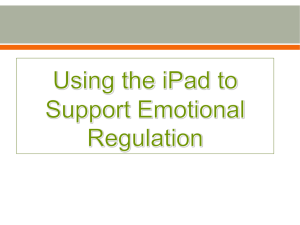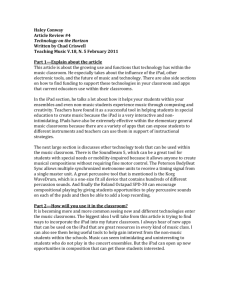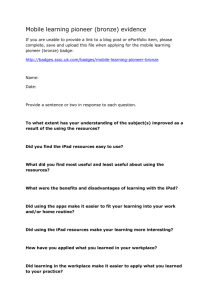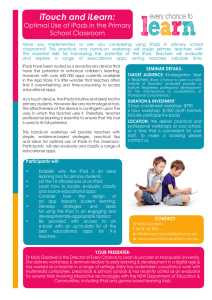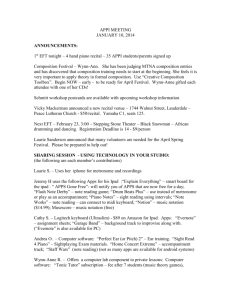Using the iPad to Support Communication, Academic, and Social
advertisement
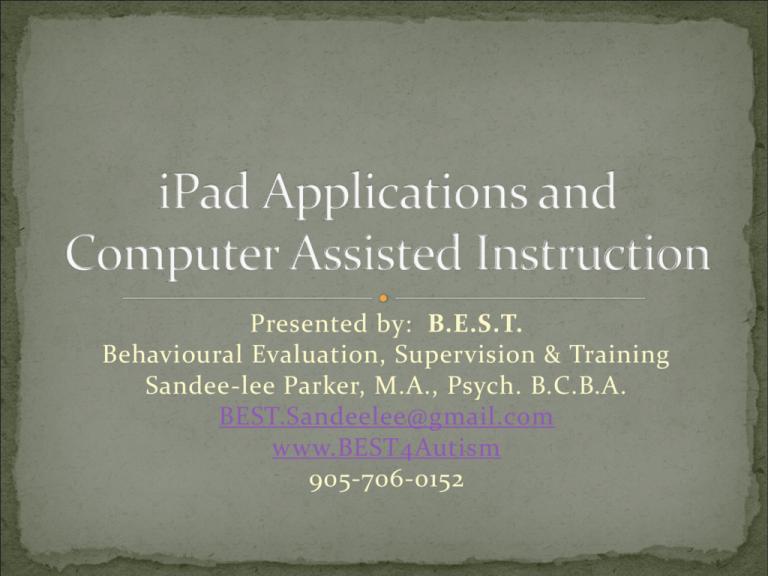
Presented by: B.E.S.T. Behavioural Evaluation, Supervision & Training Sandee-lee Parker, M.A., Psych. B.C.B.A. BEST.Sandeelee@gmail.com www.BEST4Autism 905-706-0152 If you have technical difficulties, I am not the one to assist you. tgougeon@clhmidland.on.ca Please keep your microphones on mute unless speaking to us here in Aurora We will break for ten minutes this morning, for an hour at lunch and again for 10 minutes in the afternoon. Sandee-lee: a BCBA, not a computer tech Aurora group Satellite locations Pros and Cons of Technology Parent Training iPad cases and other accessories iPad funding Various Applications Communication, Vocabulary Development, Syntax/Grammar, Fine Motor, Vocational/Self-help, Social Skills, Academics, Apps to find Apps Easy to use and to program Easy to purchase applications Inexpensive compared to computers and speech generating devices Portable Socially Acceptable and interesting to peers Can be highly personalized (e.g. photos vs board maker symbols) Children with Autism are attracted to it Children with autism can often learn how to use it with minimal instruction When children are using technology they are not interacting in the same way as through speech or sign language May have to deal with some repetitive behaviours Applications are not always malleable (programmable, adjustable, or contain enough exemplars) Not always practical in certain environments such as the pool or park. Establish rules for the modification and use of specific programs, especially Proloquo2Go, Go Talk Now, and other communication apps Teach and support parents in following through with contingencies Like all program, progress should be monitored (e.g. data collected) Doing regular back ups! Agreeing to content Some can be expenses but may save money in the long run when the iPad is not broken Cracked screens are the most common problem (Apple charges $250.00 to replace the iPad, so we hope you backed it recently) For participants in Durham Region, contact: Rob Lomas at RILTECHNOLOGIES@yahoo.ca. He can replace the cracked screen for $100.00. Visit http://blog.friendshipcircle.org (iPad cases for your child with special needs) Has been used for many years and includes low tech to high materials and devices Skills that can be addressed using technology include Communication Writing Reading Following transitions and routines Preventing challenging behaviours Social Skills If the child needs the device to communicate, it needs to move between environments Some school take issue with respect to responsibility when the device is family owned. Sending a child to school without their communication device is like sending a child to school without their wheelchair. Families may need to challenge the school’s policies on devices going to school as well as advocate for getting a device purchased by the school. My two favourites are: Prologuo2Go (189.00 USD) Go Talk Now (79.00 USD) Similar in their page set up. Go Talk Now is more difficult to program Go Talk Now has screen shots which are very useful for less able communiators. Go Talk Now can support video segments Expressionist iConverse iCommunicate Look to Learn My Talk Grace Tap to Talk Comes pre-loaded with a home page which you will want to change right away. For most children photos are better than icons and less is more. Huge vocabulary Add your own photos or google images (google images must be saved to your photo directory first) Easy, on-the-spot changes or additions to a page Can display one or many icons per page Great on-line support Many of the symbols are arbitrary and would actually require reading skills to understand what they represent. Others require some prior knowledge (understanding arrows, sign language, symbols) that may not exist yet. Photos are more clear and personalized (actual people, child’s actual school, google images for McDonalds, etc). My Day Each icon represents each activity of the day Breakfast Greeting teachers Prayer O Canada Morning Circle Break time Seat work… Touching each activity icon opens to the specifics of the activity E.g. Breakfast opens to a choice of foods and drinks as well as social comments Break time at school opens to a choice of preferred break activities Other than the overall layout of the day, I do not recommend using the iPad for task analysis (e.g. all the steps to dressing or undressing or toileting). The child cannot hold the device while engaged in these activities which mean the parent or teacher must hold it and this is not conducive to eventual independence. Low tech picture strips placed strategically are better in these situations. I want linked to preferred food vs activity The food icon opens to food choices while the activity icon opens to activity choices The activity page may have another link level. E.g. the child chooses movie and this opens to all the possible movies s/he could request. Toilet: Always on the home page but may be included on all pages during toilet training Model, prompt, model, prompt, model, prompt! There are no special strategies to teaching the child to find what s/he wants. Model how to get there. Return to the home page. Prompt, starting with hand over hand, and decreasing prompts gradually. When the child comes into contact with the reinforcer s/he will become independent in making one word requests very quickly. Context shots are not available on the Prologquo2Go. Children who cannot scan the cells or discriminate between icons, after a reasonable effort by all, should be introduced to the Go Talk Now such that they can acquire contextualized communication skills. Contextualized communication via the Go Talk Now involves taking a photo of the context (e.g. the child’s prepared snack table) and prompting him/her to choice an item. Each item has been programmed as a hotspot and will speak a phrase that you enter, such as “I would like an apple please.” Research shows that we all use the form of communication that is the least effortful (e.g. acronyms), and results in reinforcement the quickest. Some children begin to talk after several opportunities to request using a voice output device. Do not then make the child use the device after having made a verbal request. A feature that allows a message to be typed and then spoken in its entirety. Very valuable to children who can read and write. A useful tool for sharing information across environments such as home to school and school to home. Allows the child to share at school such as in circle time. Type a message Sentence is spoken when a period is pressed or the “speak” button is pressed. Preferred play-based apps may need to be removed from the iPad such that it is used as a communication device and not a toy. The device needs to be available at all times or spontaneous requests cannot emerge. (Siblings cannot play with it and parents cannot use it for email.) Communication is sending and receiving messages Vocabulary are the words that are used in Communication Language is the complex process of rules like pragmatics (social communication rules), syntax (how to make a sentence) and morphology (how letters go together to make words. Many children outgrow the Proloquo2go and other communication apps as their ability to form sentences grows. Best taught in a discrete trial format as much repetition may be required. Kindergarten.com is a great resource Tact training is an important part of communication (can’t use an icon to make a request if we don’t know what the icon represents.) Start with those words that are the most meaningful to the child (his/her reinforcers) Expand out to teaching by class (learns animal words, people, verbs, etc.) Kindergarten.com Speech with Milo An early English Words Game Mayer Johnson Learn to Talk Taught through modeling and likely some physical prompts Should only be introduced after one word requests are firmly established. Child must have a reasonable number of nouns and verbs in order to create sentences. Phrases can be chunked or individual words each represented in the sentence. Learn to talk Zombie Grammar Force Tap to Learn SAT Grammar Not easy to use in all environments. Helpful if a task requiring many steps is done in one location (cooking, academic work) iPrompts is picture based prompting app and can create a schedule or a sequence of tasks. Includes a count down timer (helpful if the schedule includes a reinforcing activity) Model me Kids: Going Places www.modelmekids.com also has DVD’s of a social skills training series. Quick Cue Stories2learn What are they thinking Hidden Curriculum for Kids Letter recognition Letter-sound correspondence (more important than letter recognition) BB Magic; Bob books Reading Comprehension There is no app available yet that teaches reading as well as Reading Mastery or Teach your Child to Read in 100 Easy Lessons. Abitalk Inc. focuses on reading and math apps Also, many apps are found on kindergarten.com Teach me: Toddler, Kindergarten, Gr 1 Super Why ABA Match ups Intro to Letters (by Montessorium) Grasshooperapps.com May need to start at the word level with word to object matching. Simple sentences such as Reading Comprehension Grades k to 1 Kids Reading Comprehension Bob Books Number recognition Counting 1:1 Correspondence Addition Subtraction Math facts (fluency) Grasshopperapps.com Bert’s Bag (counting skills) Ace Math Flash Cards (fluency) Big Number flashcards (number recognition) Number Fiesta (mixed skills) Autism Apps Autism IHelp Continue to check for new and exciting training events at: www.kerrysplace.org & BEST4Autism.ca

